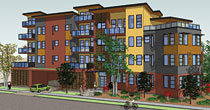Cohousing
A New Option for Seniors
by Eliza Meggs

How and Where Are You Going to Spend Your Senior Years?
There are many of us approaching retirement thinking about this very thing. Boomers are not satisfied with the institutional living that is offered to the elderly in our society. We are used to taking charge of our own lives.
Dr. William H. Thomas has done much work around the lives of the elderly. He developed a philosophy he called the Eden Alternative, first described in his 1994 book called The Eden Alternative: Nature, Hope, and Nursing Homes. Dr. Thomas believes that there are three plagues of growing older: loneliness, helplessness, and boredom. Although his work has been to improve the lives of seniors in nursing homes, those of us in our 50s and 60s can take his philosophies to heart and begin to build a life for ourselves now that will help us to age with dignity, surrounded by friends and family.
Why not group together and look after each other? Can we imagine a living arrangement that provides privacy when we want it and company when we need it? Can we avoid becoming a burden to our families? If our families live at a distance, or we have no family, why not create our own families? A group of Saskatoon residents is attempting to do just that by developing an intentional seniors’ community called cohousing.
What is Cohousing?
In his book, The Senior Cohousing Handbook: A Community Approach to Independent Living, Charles Durrett states that cohousing is an old idea that is applicable to our times. “Cohousing offers the social and practical advantages of a closely-knit neighbourhood consistent with the realities of 21st-century life.” (p. 17) He also quotes Hans S. Anderson, cohousing organizer: “Cohousers are simply consciously creating the community that used to occur naturally.” (p. 17)
The concept of cohousing began in Denmark forty years ago. Single family homes or apartments, all of which were self-sufficient, were grouped around a common house. The common house was the heart of the community , with a kitchen for community dinners, and other areas for a variety of personal and social activities. Strangers became neighbours; neighbours became friends.
This process of strangers becoming friends is possible through the unique development of these communities. The individuals who want to live in this way come together to develop and design their new homes. Working together helps bond the individuals and produces living arrangements that meet the specific needs of that community.
Charles Durrett tells us that cohousing, both intergenerational and seniors, has spread from Denmark, becoming popular in other parts of the world. The first cohousing projects in the United States were started in 1991 and by 2009 there were over 100 completed communities.
In Canada, there are nine completed communities with eight others in development. (Canadian Cohousing Network). The community in Saskatoon will be the first seniors’ cohousing in Canada.
Wolf Willow Cohousing
Two years ago, a group of friends started investigating alternative living arrangements where they could age in a place with dignity, surrounded by friends. Living in isolation in their homes or conventional apartment or condo units was very unappealing, as was the idea of a nursing home. They wanted to create a life that would keep them healthy, active, and vibrant as far into their senior years as possible; a life where they could share resources, have fun together, and look after each other. They would balance privacy and social activity. They found cohousing and have called their project Wolf Willow.
Much has happened in those two years. The seven friends (four households) have grown to twenty-five individuals. Sixteen of these people, representing nine households, are equity members. They have made the decision, both philosophically and financially, to become members of Wolf Willow. The others are associate members, who are considering the move. They participate in the meetings as a way of becoming acquainted with the other people with whom they may be living.
A project manager has been hired to help navigate the way from idea to move in. She lives in cohousing herself and has managed the development of most of the completed communities in Canada. An architect who has designed other cohousing and a construction company from Saskatoon, are also working with the group.
Wolf Willow Cohousing, an apartment style condominium of about 20 homes, planned for adults 55 years of age and over, will be situated at 920-17th Street and Avenue J. The location will fulfill the desire for active aging. A pedestrian/bike path on 17th Street leads to Victoria Park, River Landing, and the Farmers’ Market. The many attractions of downtown are also within walking or biking distance.
In her book, You Could Live a Long Time: Are you Ready?, Lyndsay Green tells us that we should be building up our Retirement Emotional Circle Plan (RECP) as there is a “strong link between the health, well-being, and quality of life of older people, and the strength and quality of their social relationships and community engagement.” (pp. 22–23) The friends involved in Wolf Willow Cohousing are building their RECP.
Bibliography: Canadian Cohousing Network, www.CanadianCohousingNetwork.ca., 2004; Durrett, Charles, The Senior Cohousing Handbook: A Community Approach to Independent Living, New Society Publishers, Gabriola Island, BC, Canada, 2009; Green, Lyndsay, You Could Live a Long Time: Are You Ready?, Thomas Allen Publishers, Toronto, Canada, 2010; Thomas, William H., Dr., The Eden Alternative: Nature, Hope, and Nursing Homes, The Eden Alternative Foundation, 1994.
Eliza Meggs is a member of Wolf Willow Cohousing. If you would like more information on this project please go to the website www.wolfwillowcohousing.ca. Better yet, please join them at one of their monthly information sessions, the dates of which are posted on the website.
|
